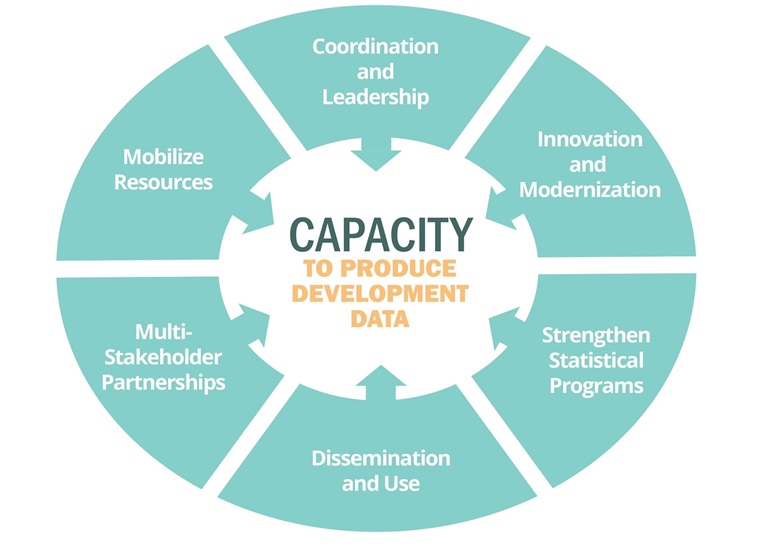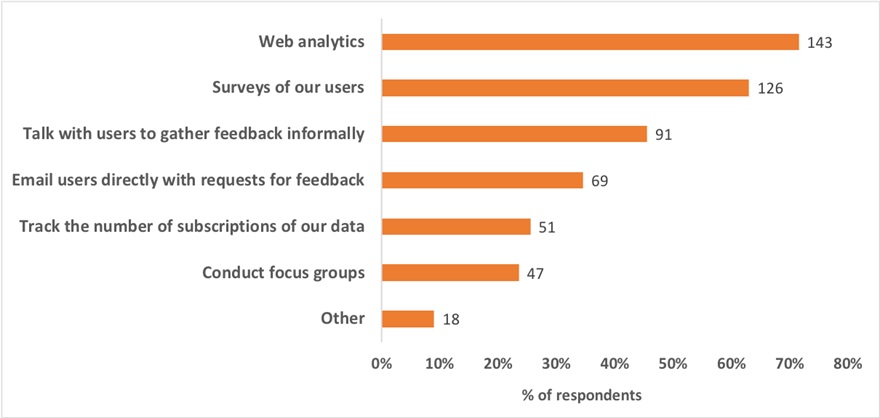The first United Nations World Data Forum launched the Cape Town Global Action Plan for Sustainable Development (CTGAP), an ambitious yet essential commitment to innovate and modernize national statistical systems, among other priorities. As policymakers, development partners and other data advocates prepare to gather at the second UN World Data Forum in Dubai in October, it is an opportune moment to ask how these various actors can effectively implement this Plan.
A critical piece of this puzzle is to be able to better support national statistical offices (NSOs) in increasing the use and impact of official statistics and facilitating better data dissemination strategies. Open Data Watch, AidData and PARIS21 have teamed up to address these two needs through an exciting, collaborative research study (Financial support provided by the Hewlett Foundation). This blog presents a preview of findings from this two-part project, ahead of our session where we will launch the full report at the UN World Data Forum.
The 2030 Agenda has placed increased demands on NSOs in terms of the quantity and quality of data that needs to be collected to effectively monitor the sustainable development goals (SDGs). The CTGAP is a global plan for the planning and implementation of statistical capacity building necessary to achieve the scope and intent of the 2030 Agenda. The national statistical system -- NSOs and other agencies designated to collect, compile and disseminate official statistics -- is central to making progress on its six strategic areas (Figure 1).
Figure 1: Six strategic areas of the Cape Town Global Action Plan

Source: Open Data Watch
However, despite the increased demand for development data from NSOs, there are barriers that limit the full potential of official statistics to bring about the desired change in society. Some of these include, but are not limited to, the timeliness and perceptions of accuracy of the data, due to both technical and political constraints. In sum, there remains a broken link in the data value chain between the production of official statistics and its dissemination and use.
To close the gap between production of official statistics on the one hand, and its dissemination and use on the other, development partners and other actors need a better understanding of the NSO perspective and the barriers they face with disseminating, monitoring and increasing data use. And to assist the modernization of statistical systems, an analysis of usage statistics from national data portals and NSO websites is also necessary.
Snap Poll Reveals a Strong Demand for Monitoring Data Use Among NSOs
To capture the producer perspective on official statistics, AidData sent an online snap poll to senior- and mid-level officials in NSOs in 140 low- and middle-income countries. The survey covered four broad topics: the most important and frequent users of data produced by NSOs, current monitoring of data use and dissemination methods, the key improvements to encourage data use, and what they need to make those improvements. Around 390 officials responded to the survey, for a response rate of 32 percent.
Contrary to what might be expected based on their primary mandate to collect, analyze and disseminate data, most NSOs reported monitoring the use of data they produced. Among the 40 percent who said they did not currently measure the use of their data, 90 percent said that it was very important or quite important for the NSO to be able to measure the use of data it produces. This suggests that NSOs see the value of monitoring data use, but may not be currently doing it either due to other competing priorities or capacity constraints.
The most common way of monitoring data use was through web analytics. While more than 70 percent of those that currently monitored data use did it through web analytics, more than 85 percent of those that would like to monitor data use also chose this as their preferred way (Figure 2). This suggests that NSOs that do not currently monitor data use would appreciate support in using web analytics for their data portals or websites hosting official statistics.
Figure 2: Current ways that NSOs monitor the use of data they produce

Notes: This figure is based on the question: How do you measure the use of data produced by [NSO]? The question was only asked to those respondents that said they monitor data use. Respondents could select all that apply. Data labels represent the number of respondents that selected a certain response option.
Monitoring Data Portals Reveals a Preference for Economic Statistics Among Users
One of the objectives under the CTGAP is to "develop and promote innovative strategies to ensure proper dissemination and use of data for sustainable development." To aid efforts to publish official statistics in open data formats for measuring and tracking development progress, several NSOs have created national data portals or platforms. Our snap poll findings point to a demand for effectively monitoring and analyzing how data are accessed, particularly through web analytics.
The second part of this project, conducted in partnership with PARIS21, was designed to help countries understand how users access official statistics through NSO websites. By analyzing user activity on these websites using Google Analytics, countries can learn more about who is accessing their website and what interests these users may have. Initial findings show that the vast majority of users accessing these websites come from within the country itself. This could include government officials, academics, citizens, and staff of international organizations based in that country.
Economic-related statistics seem to be the most popular, as the pages hosting these statistics are the most visited pages on NSO websites, with some additional interest in social data on population and poverty. Aside from pages related to official statistics, pages related to job opportunities with the NSO receive a great deal of web traffic.
Informing future statistical capacity building initiatives
Insights from the snap poll and the data portals study reveal the producer and user perspective on the use of official statistics. By identifying the key barriers to use, the most effective dissemination strategies and organizational needs of NSOs, this study will inform the efforts of development partners, governments and civil society organizations in implementing the CTGAP. The recommendations can help align future approaches to statistical capacity building with what NSOs need the most.
While this blog only provided a sneak peek into what we're learning from this joint research, the World Data Forum presents an excellent forum to share the findings and recommendations from the full report widely, and spur a discussion around the use and monitoring of official statistics at the session "New Engagement Approaches for NSOs to Increase Data Use" on October 23. Open Data Watch, AidData and PARIS21 look forward to engaging with NSOs, development partners and data advocates to narrow the gap between production and use of official statistics and implementing initiatives that can maximize the impact of this data.
Deirdre Appel is Program Manager at Open Data Watch.Tanya Sethi is a Senior Research Analyst at AidData.

